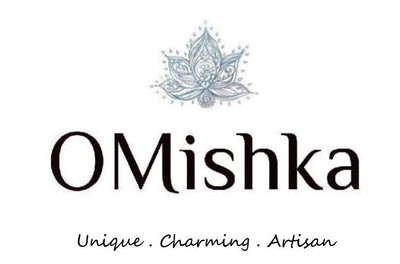Materials
OMishka products are lovingly and expertly handcrafted using the finest eco-friendly natural materials.
COCONUT

Botanically speaking a coconut is a fibrous one-seeded drupe. It is not a tree since there is no bark, branches or secondary growth. A coconut takes around 11 to 12 months to reach maturity. Coconuts are rich in iron, calcium, copper, magnesium, zinc, manganese, mineral salts and beta-carotene. The colour of the coconut varies from a yellow-beige through mid and dark browns to almost black depending on the stage of its development. OMishka uses many different types of coconut. Earrings are made from the puttee which is a smaller relative of the coconut.
WOOD

Ornamental jewellery made from wood are light weight and of a vast versatility. The hardness of the wood will depend on the type of wood being used. There are many different types of wood which are used for this purpose including Palm wood (Coconut wood), Black wood, Indian Rosewood, Sandalwood, Ghana wood, Pacific Oak wood and Olive Wood.
BRASS

Brass is an alloy (mix) of copper and zinc and it is nickel free. It can be produced in a range of colours from deep red to golden yellow depending on the polishing process of the metal. It can be formed into any desired shape and form whilst retaining a high strength. This makes it is one of the most popular metals to be used in creating jewellery. Oxidation and slight design variances are part of the allure of these distinctive pieces. The brass is then polished leaving the black colouring only in the grooves of the product. This allows tiny details and patterns to stand out. Brass is generally deemed to be very good for people with sensitive skin.
STERLING SILVER

This is the most common form of silver mainly consisting of 92.5% silver with the rest made up in base metals usually copper. As the copper oxidises the sterling silver will tarnish but can be easily brought back to its full shine. The copper element of sterling silver also makes for a much stronger alloy than pure silver. Sterling silver is great for jewellery making as it is so strong and malleable.
SILVER PLATE

OMishka jewellery that is silver-plated starts out as brass and is then coated with microscopic layers of sterling silver using electricity. It is a process known as electroplating. The plated components are nickel free meaning that this is generally good for people with sensitive skin. All are high quality silver-plated products but still much less expensive than the sterling silver options. The coating of silver over the brass is layered multiple times and again the metal is polished leaving the black colouring only in the grooves of the product allowing tiny details and patterns to stand out.
COTTON

Cotton is a soft, fluffy staple fibre. The plant is a shrub native to tropical and sub-tropical regions around the world including India. The fibre is most often spun into yarn or thread and used to make a soft, breathable textile. It has been spun, woven, and dyed since prehistoric times.
ORGANIC COTTON

Organic cotton is generally defined as cotton that is grown organically in sub tropical countries from non-genetically modified plants without the use of any synthetic agricultural chemicals such as pesticides. Now being used more and more in the textile industry.
BAMBOO

Bamboo is a very fast growing, sturdy and sustainable tropical forest product which does not require the use of pesticides and herbicides to thrive. For years it has been touted as being one of the most environmentally friendly fabrics on the market. It can easily be blended with cotton, hemp and even lycra. The fibre is naturally smooth meaning there are no sharp spurs to irritate the skin. Bamboo can feel like silk or very soft cotton and has many anti-bacterial qualities.
HIMALAYAN 'YAK WOOL'

Acrylic fleece is lightweight, incredibly soft and very warm with a wool like feel. The acrylic that is used in OMishka products is made from recycled hard plastics for example water bottles rather than an animals fluffy coat giving it an eco-friendly edge. People with sensitive skin will find this non-itchy and it's a perfect material for outerwear and all things cosy.
Unfortunately many sellers lie to their customers knowing that these shawls and blankets are not in fact genuine Himalayan yak wool and are only telling you what they think you want to hear. Genuine yak wool is a luxury fibre and comes with a hefty price tag. It is also very itchy and coarse and only comes in two colours, brown and black. It is impossible to dye with colour and does not wash well. If you are ever unsure then do the burn test - acrylic fibre will quickly turn black and smell like rubber whereas genuine yak wool will slowly burn and smell like human hair. And don't always believe the labels as it is easy to print off a label and sew it on a garment. I have seen this done many times.
It's good to be honest about the product you are buying.
